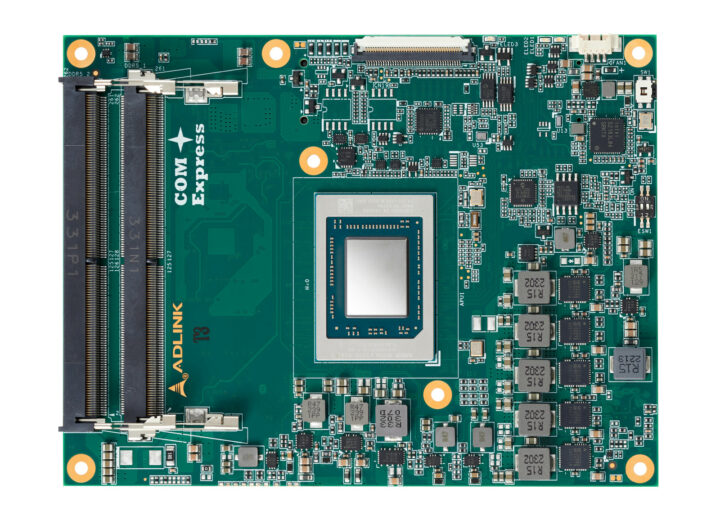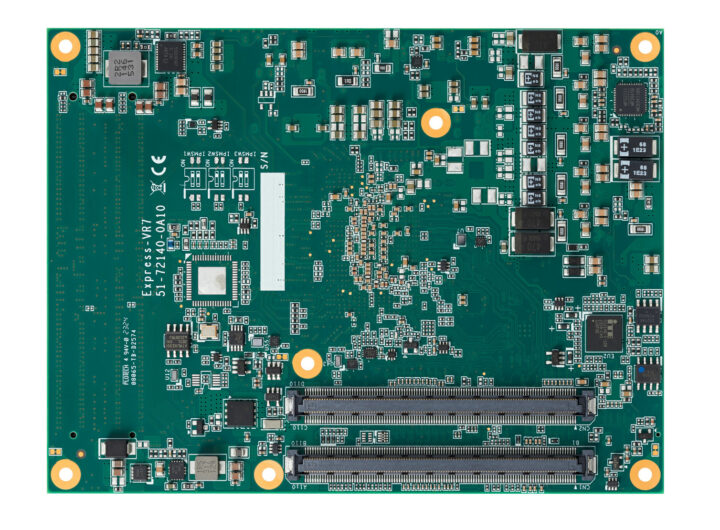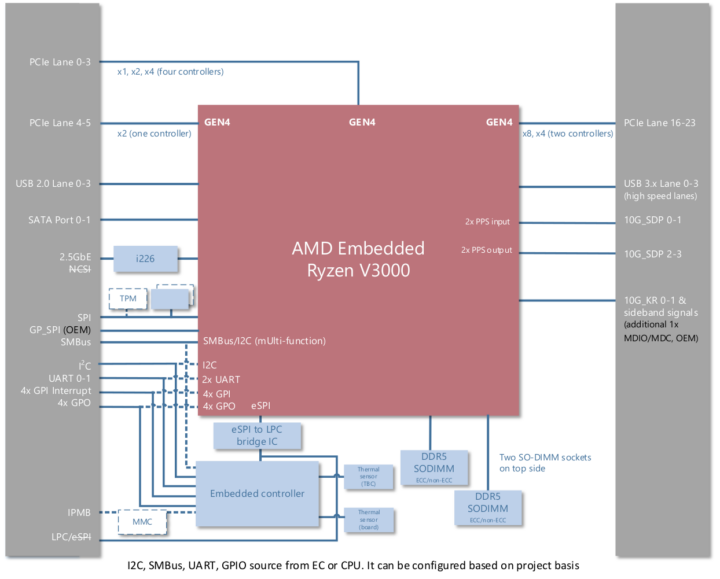ADLINK Express VR7 is a COM Express Basic size Type 7 computer-on-module powered by the eight-core AMD Ryzen Embedded V3000 processor with two 10GbE interfaces, fourteen PCIe Gen 4 lanes, and optional support for the “extreme temperature range” between -40°C and 85°C.
The COM Express module supports up to 64GB dual-channel DDR5 SO-DIMM (ECC/non-ECC) memory and targets headless embedded applications such as edge networking equipment, 5G infrastructure at the edge, video storage analytics, intelligent surveillance, industrial automation and control, and rugged edge servers.
Express-VR7 specifications:
- SoC – AMD Embedded Ryzen V3000 (one or the other
- Ryzen V3C48 8-core/16-thread processor @ 3.3/3.8GHz; TDP: 45W
- Ryzen V3C44 4-core/8-thread processor @ 3.5/3.8GHz; TDP: 45W
- Ryzen V3C18I 8-core/16-thread processor 1.9/3.8GHz; TDP: 15W (useful in the extreme temperature range)
- Ryzen V3C16 6-core/12-thread processor 2.0/3.8GHz; TDP: 15W
- Ryzen V3C14 4-core/8-thread processor 2.3/3.8GHz; TDP: 15W
- System Memory – Up to 64GB (2x 32GB) dual-channel ECC/non-ECC DDR5 memory up to 4800 MT/s via two SODIMM sockets
- On-module chips
- Embedded BIOS – AMI UEFI with CMOS backup in 32 or 16MB (TBC) SPI BIOS (dual BIOS by build option)
- Intel i226 2.5GbE controller
- 2x 220-pin connectors with
- Storage – 2x SATA III 6 Gbps
- Networking
- 2x 10GBASE-KR and its sideband signals
- 1x 2.5GbE interface
- USB – 4x USB 3.x/2.0/1.1
- Expansion buses
- 8x PCI Express Gen4: Lanes 16-23 (configurable to one x8, two x4, two controller)
- 4x PCI Express Gen4: Lanes 0-3 (configurable to four x1, two x2, one x4, four controller)
- 2x PCI Express Gen4: Lanes 4-5 (configurable to one x1, one x2, one controller)
- LPC bus (through an ESPI to LPC bridge IC), SMBus (system), I2C (user), GP_SPU (user, project basis)
- Serial – 2x UART ports with console redirection
- IOs – 4x GPO and 4x GPI (with interrupt)
- SEMA Board Controller – Voltage/current monitoring, power sequence debug support, AT/ATX mode control, logistics and forensic information, flat panel control, general purpose I2C, watchdog timer, fan control and failsafe BIOS (dual BIOS by build option)
- Optional IPMB (in conjunction with carrier BMC for remote management Controller applications) by build option
- Super I/O – Supported on carrier if needed (standard support for W83627DHG-P, other Super I/O supported on request)
- Debug Headers – 40-pin multipurpose flat cable connector for use with DB40-HPC debug module providing BIOS POST code LED, EC access, SPI BIOS flashing, power testpoints, debug LEDs
- Security – Infineon TPM 2.0 (SPI based)
- Power Management
- Standard Input – ATX: 12V±5% / 5Vsb ±5%; or AT: 12V±5%
- ACPI 5.0 compliant
- Power States – C1-C6, S0, S1, S3, S4, S5 , S5 ECO mode (Wake on USB S3/S4, WOL S3/S4/S5)
- Dimensions – 125 x 95 mm (PICMG COM.0: Rev 3.1 Type 7 Basic size)
- Temperature Range
- Operating – Standard: 0°C to 60°C; Extreme Rugged: -45°C to 85°C (build option, selected SKUs)
- Storage – Standard: -20°C to 80°C; Extreme Rugged: -40°C to 85°C (CNXSoft: That’s odd the storage range is lower than the operating range…)
- Humidity
- 5-90% RH operating, non-condensing
- 5-95% RH storage (and operating with conformal coating)
- Shock and Vibration
- IEC 60068-2-64 and IEC-60068-2-27
- MIL-STD-202F, Method 213B, Table 213-I, Condition A and Method 214A, Table 214-I, Condition D
- HALT – Thermal Stress, Vibration Stress, Thermal Shock and Combined Test
ADLINK provides standard support for Yocto Linux and Ubuntu 20.04.3 LTS, as well as extended support for Yocto Project-based Linux, which I suppose means they offer paid services to customize their Yocto BSP. The company will eventually provide I-Pi development kits based on the Express-VR7 module for easy prototyping and evaluation, but no ETA was provided in the press release.
The Express-VR7 COM Express module based on AMD Ryzen Embedded V3000 SoC does not seem to be available at this time with all information preliminary. A few more details may be found on the product page.

Jean-Luc started CNX Software in 2010 as a part-time endeavor, before quitting his job as a software engineering manager, and starting to write daily news, and reviews full time later in 2011.
Support CNX Software! Donate via cryptocurrencies, become a Patron on Patreon, or purchase goods on Amazon or Aliexpress







